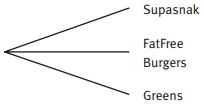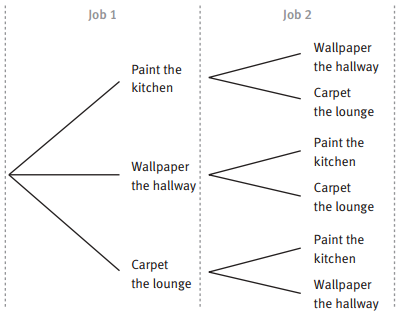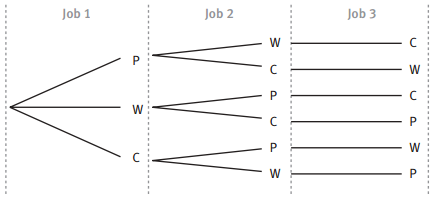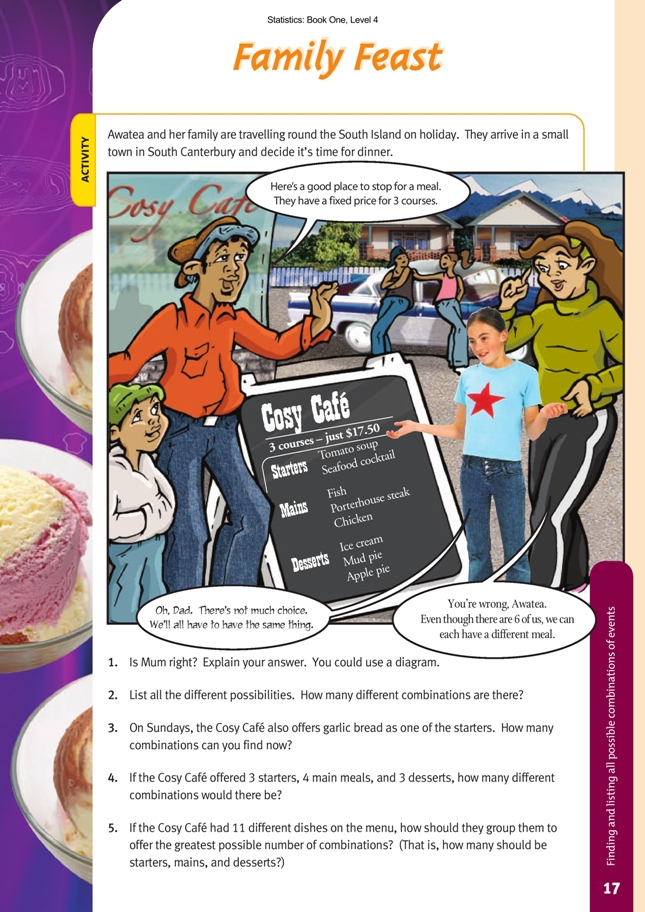This is a level 4 statistics activity from the Figure It Out series.
A PDF of the student activity is included.
Click on the image to enlarge it. Click again to close. Download PDF (256 KB)
find all possible outcomes using a tree diagram
evaluate findings from probability activities
This is a straightforward activity that students could do simply by listing all the possible outcomes. However, it is important that they learn to be systematic so they do not miss any of the options. One of the best ways is to use a tree diagram. Of the three activities in this book suited to the use of tree diagrams, this is the simplest, so it is best tackled before Catch of the Match and Game Show (pages 18 and 24 of the students’ book).
Although tree diagrams are a useful tool, students often do not understand how to draw them or interpret them. The following notes explain a number of important points.
Branches begin at a common point on the left-hand side of the page. The number of branches depends on the number of options. In the following scenario, a family is deciding which of the three local restaurants to go to for a meal:
The various outcomes should be lined up vertically. (The vertical lines in the examples below, and in some of the diagrams in the Answers, are only an aid to tidy construction.)
If there is more than one decision to be made, there will be another set of branches to the right of the first.
For example, this family decides that they can afford to eat out two Friday nights in a row. Their options can be set out in this way:.png)
Often the second option eliminates whatever choice was made the first time around. In the following scenario, a couple thinks about the order in which they should do major jobs around their home. Clearly, once they have painted the kitchen (for example) they can tick that off their list:
To reduce the clutter in diagrams, it is common to abbreviate the names of the options or outcomes. So the above scenario, including job 3, becomes:
Note that it is much easier to construct a tree diagram using a computer drawing program than it is to draw one tidily by hand. Diagrams usually involve a lot of repetition, and copying, pasting, and grouping reduce the work involved. Also, using a computer, it is very easy to space branches evenly and to line them up vertically.
If they look down the last column of any tree diagram, the students can see how many branches there are by the number of ends or terminations. If they read along each branch from left to right, they can see what each branch represents. For example, the branch that reads WCP represents the outcome in which wallpapering is followed by carpeting, then painting.
Answers to Activity
1. Yes, Mum is right. A tree diagram will show this:.png)
2. TFI, TFM, TFA, TPI, TPM, TPA, TCI, TCM, TCA, SFI, SFM, SFA, SPI, SPM, SPA, SCI, SCM, SCA. There are 18 different combinations of 3 courses.
3. 27
4. 36
5. 4 starters, 4 mains, and 3 desserts give 48 combinations. The order makes no difference (for example, 3 starters, 4 mains, and 4 desserts also give 4 combinations).
